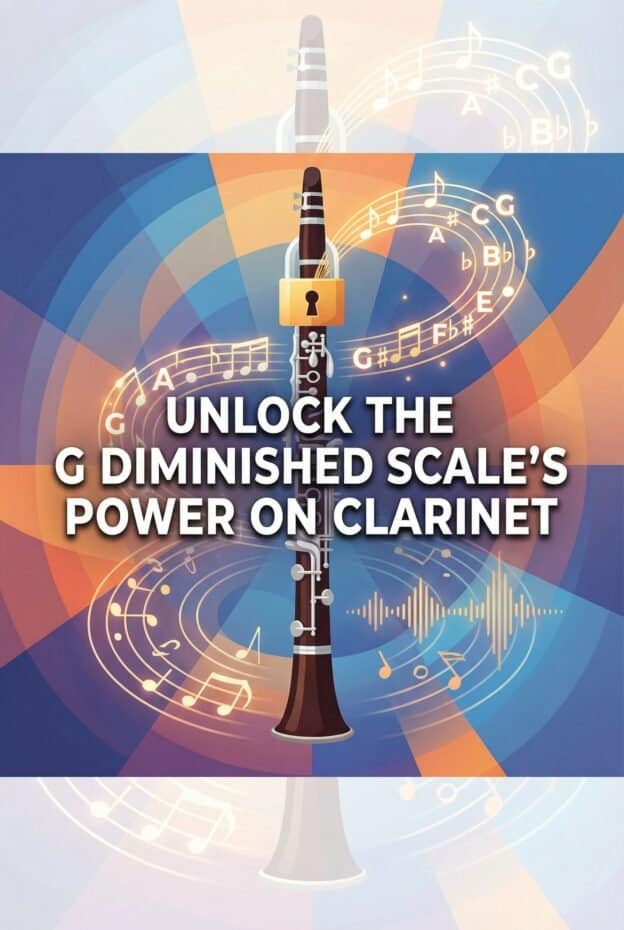The G Whole-Half Diminished Scale (on clarinet) is an 8-note octatonic pattern built of alternating whole and half steps starting on G: G-A-Bb-B-C#-D-E-F. For clarinetists, it uses standard chalumeau and clarion fingerings, with careful register-key use across the break, and is best practiced through slow patterned runs, interval drills, and short jazz phrases in all registers.
Quick Overview: What Is the G Whole-Half Diminished Scale?
The G Whole-Half Diminished Scale is an 8-note, symmetric scale built from alternating whole and half steps starting on G. The pitch set is: G, A, Bb, B, C#, D, E, F, then back to G. On clarinet, it lies comfortably across the chalumeau and clarion registers and is a core sound for diminished chords and dominant 7b9 harmony.
Because the pattern repeats every minor third, the same scale shape works over several roots. Clarinetists use this scale to outline G diminished 7 chords, E7b9, C7b9, and Bb7b9, among others. It appears in jazz improvisation, 20th century classical music, and advanced technical studies for clarinet.
Scale Anatomy: The Whole-Half Pattern and Why It Works
The G Whole-Half Diminished Scale follows a strict interval pattern: whole step, half step, whole step, half step, and so on. In scale degrees from G, that pattern is: G to A (whole), A to Bb (half), Bb to B (whole), B to C# (half), C# to D (whole), D to E (half), E to F (whole), F to G (half).
This symmetric construction creates a repeating structure every minor third. G, Bb, Db (C#), and E share the same whole-half diminished scale. For clarinetists, that means one fingering pattern can serve several harmonic contexts, which is powerful for improvisation and technical drills.
Harmonically, the scale outlines a fully diminished seventh chord built on G: G, Bb, Db (C#), E. It also contains the chord tones and tensions of several dominant 7b9 chords. For example, over E7, the scale supplies 1, b9, #9, 3, #11, 5, 13, and b7, giving a rich altered dominant color.
On clarinet, the even alternation of whole and half steps can feel mechanically smooth but acoustically unstable if air and voicing are not secure. The symmetric pattern encourages fast, pattern-based practice, which helps develop even finger motion and accurate chromatic facility across the break.
Clarinet Fingering Charts: G Whole-Half Diminished (All Registers)
Clarinetists need register-aware fingerings for the G Whole-Half Diminished Scale so that the pattern stays smooth through the chalumeau, throat tones, and clarion registers. The written scale below assumes a Bb clarinet reading concert F Whole-Half Diminished. All fingerings are written-pitch for Bb clarinet.
Chalumeau register: low G to middle B
Here is the G Whole-Half Diminished Scale from low G up to B in the chalumeau register, using standard fingerings on a Boehm-system clarinet.
Ascending, chalumeau:
- G: lowest left-hand tone hole plus all right-hand fingers (standard low G)
- A: lift right-hand ring finger (standard low A)
- Bb: A plus left-hand first finger side key or register key plus A (choose your preferred low Bb fingering)
- B: lift side key, use standard B (left-hand first and second fingers, no register key)
- C#: standard low C# (right-hand first finger only)
- D: standard low D (right-hand first and second fingers)
- E: standard low E (right-hand first, second, third fingers)
- F: add left-hand first finger to E (standard low F)
Descending, chalumeau: Reverse the fingerings: F, E, D, C#, B, Bb, A, G. Focus on clean motion between B and Bb, and between C# and D, where uneven fingers often cause bumps or timing issues.
Across the break: chalumeau to clarion G
To extend the G Whole-Half Diminished Scale through the register break, you will move from chalumeau F to clarion G and continue the same pitch set in the upper register. This is where many clarinetists feel instability, so slow practice is important.
Ascending through the break:
- F (chalumeau): low F as above
- G (clarion): left-hand first, second, third fingers plus register key
- A: left-hand first and second fingers plus register key
- Bb: A plus side Bb key or A plus register and 1-2-3 with right-hand 1 (choose the most stable for you)
- B: left-hand first finger plus register key
- C#: no fingers, register key only (open C#)
Practice F (chalumeau) to G (clarion) slowly with full air support and a steady embouchure. The register key should move cleanly with minimal extra finger pressure. Avoid biting to force the higher note; use voicing and air speed instead.
Clarion register: G to high F
In the clarion register, the G Whole-Half Diminished Scale uses standard upper-register fingerings. Here is a practical range from clarion G up to high F:
Ascending, clarion:
- G: left-hand 1-2-3 plus register key
- A: left-hand 1-2 plus register key
- Bb: A plus side Bb key or 1-2-3 plus register key and right-hand 1 (test both for tuning)
- B: left-hand 1 plus register key
- C#: open with register key
- D: left-hand 1 plus right-hand 1-2 with register key
- E: left-hand 1-2 plus right-hand 1-2 with register key
- F: left-hand 1-2 plus right-hand 1-2-3 with register key
Descending, clarion: F, E, D, C#, B, Bb, A, G. Pay attention to the open C# to B motion, which often causes pitch drops or finger noise. Keep fingers close to the keys and maintain a firm, consistent airstream.
Altissimo extension: beyond high F
Advanced players may extend the scale into the altissimo register. Common fingerings vary by instrument and setup, so treat these as starting points and adjust for intonation:
- High G: typical fingering is clarion D plus register and left-hand third finger vent key (or alternate G3 fingering specific to your clarinet)
- High A: often based on clarion E with added side keys; consult a detailed altissimo chart
Because altissimo fingerings are highly instrument dependent, keep a written fingering chart handy and mark which options tune best for the G Whole-Half Diminished Scale. Record yourself to check consistency across the pattern.
Practical Exercises and Warm-Ups for Clarinetists
To make the G Whole-Half Diminished Scale reliable on clarinet, build a short daily routine that targets finger coordination, air support, and ear training. Start with slow, legato patterns, then add articulation, rhythmic variation, and register shifts.
Slow scale and broken thirds
Begin with the basic scale in quarter notes at a slow tempo, such as ? = 60. Play from low G up to high F and back, all slurred. Focus on even tone and consistent intonation, especially across the break between chalumeau F and clarion G.
Next, practice broken thirds within the scale: G-Bb, A-B, Bb-C#, B-D, and so on. Continue this pattern through the full range. Broken intervals help you hear the diminished color more clearly and improve finger independence for non-stepwise motion.
Interval studies: minor thirds and tritones
The whole-half diminished sound is built around minor thirds and tritones. Practice the scale in alternating minor thirds: G-Bb, A-C, Bb-Db, B-D, etc., both slurred and tongued. Then practice tritones: G-Db, A-Eb, Bb-E, B-F, and so on.
Use a tuner or drone on G to keep these dissonant intervals centered. Pay attention to pitch tendencies in the throat tones and open C#, which often run sharp or flat depending on your embouchure and instrument setup.
Rhythmic patterns and articulation
Once the fingerings feel secure, add rhythmic variation. Try eighth-note triplets, sixteenth notes, and syncopated groupings of 3 and 5 notes across the bar line. Keep the metronome steady and increase tempo only when the pattern is clean and relaxed.
Alternate articulation patterns such as slur 2-tongue 2, tongue 4, and accent every third note. These patterns prepare you for real musical phrases where the diminished scale appears in varied rhythmic contexts, especially in jazz solos and modern etudes.
Short jazz phrases and call-and-response
Create 2-bar and 4-bar phrases using only notes from the G Whole-Half Diminished Scale. For example, over an E7 chord, improvise a line that ascends from G to E, then resolves to A or D in the next bar. Record yourself and listen for clear direction and strong time.
Teachers can use call-and-response: the teacher plays a short diminished phrase, and the student imitates it exactly, then answers with a new idea using the same scale. This builds vocabulary and helps internalize the sound of the scale in a musical context.
Applying the Scale: Improvisation, Composition, and Genre Uses
The G Whole-Half Diminished Scale is especially useful over diminished 7 chords and dominant 7b9 chords. On clarinet, it gives a bright, tense color that cuts through ensembles in jazz, big band, and contemporary classical music.
Improvisation over diminished and dominant chords
Use G Whole-Half Diminished over Gdim7, Bbdim7, Dbdim7, and Edim7, since the scale shares chord tones with all four. It also works well over E7b9, C7b9, and Bb7b9, where the scale supplies altered tensions like b9, #9, and 13.
For example, on a ii-V-I in D minor (Em7b5 – A7b9 – Dm), you can use G Whole-Half Diminished over A7b9 to create a strong pull into D minor. Clarinetists can practice looping this progression and improvising lines that emphasize chord tones on strong beats.
Classical and 20th century repertoire
Composers such as Igor Stravinsky, Béla Bartók, and Olivier Messiaen used octatonic and diminished collections in orchestral and chamber works. While they may not label the scale explicitly, clarinet parts often feature symmetric patterns and diminished runs that align with the whole-half structure.
Clarinetists studying 20th century repertoire can analyze these passages to identify where octatonic material appears. Practicing the G Whole-Half Diminished Scale and its transpositions prepares you for these technically and harmonically complex sections.
Composition and arranging ideas
Composers and arrangers can use the G Whole-Half Diminished Scale to create tension before cadences, especially in clarinet solos or exposed lines. For instance, a rising diminished run into a sustained consonant note can heighten drama in film scores or concert works.
Because the scale is symmetric, you can sequence a short motif every minor third and still stay within the same pitch set. This makes it easy to build coherent, yet unpredictable, clarinet lines that sound advanced without requiring new finger patterns for each modulation.
Historical Context and Notable Recordings (Archive References)
The whole-half diminished, or octatonic, scale gained prominence in early 20th century classical music and later in jazz. Musicologists trace its systematic use to composers like Rimsky-Korsakov and Stravinsky, who explored symmetric scales for their ambiguous tonal centers and colorful harmonies.
In jazz, diminished and octatonic sounds became common in the swing and bebop eras. Clarinetists in big bands, such as Benny Goodman in the 1930s and 1940s, often outlined diminished chords and altered dominants that align with whole-half diminished patterns, especially in turnarounds and intros.
Later, saxophonists and trumpeters like Charlie Parker and Dizzy Gillespie used diminished scales extensively in bebop vocabulary. Jazz theory texts, including Jamey Aebersold materials and Mark Levine's “The Jazz Theory Book,” describe the whole-half diminished scale as a primary tool over 7b9 chords.
Recordings of mid-century clarinetists in modern classical works also reveal octatonic usage. While not always labeled as G Whole-Half Diminished specifically, the same pitch collections appear in clarinet parts by composers influenced by Stravinsky and Bartók, giving historical context to the scale's role in clarinet literature.
Instrument Anatomy & How It Affects Diminished Fingering
The clarinet's cylindrical bore, register key system, and tone hole layout strongly influence how the G Whole-Half Diminished Scale feels under the fingers. Understanding this anatomy helps you choose fingerings that keep the scale smooth and in tune across registers.
Register key and throat A
The register key, operated by the left thumb, shifts the instrument from chalumeau to clarion by overblowing a 12th. When playing the G Whole-Half Diminished Scale through the break, the register key must coordinate precisely with the left-hand fingers, especially moving from low F to clarion G.
The throat A and side keys affect several notes within the scale, such as Bb and B in the upper part of the chalumeau and lower clarion. Alternate fingerings, including forked or cross-fingered options, can stabilize intonation but may change response. Experiment to find the best match for your instrument.
Tone hole layout and cross-fingerings
The clarinet's tone holes are not evenly spaced, which affects tuning and resistance for certain notes. In the G Whole-Half Diminished Scale, cross-fingered notes like Bb and some altissimo fingerings can feel more resistant or unstable compared to fully vented notes like A or D.
When you practice fast diminished runs, pay special attention to these cross-fingered notes. Keep fingers close to the keys to minimize motion, and use firm, fast air to help the instrument speak clearly through these more complex acoustic configurations.
Bore, register break, and response
The cylindrical bore and the large interval between chalumeau and clarion registers create the well-known register break. Symmetric scales like the whole-half diminished pattern often cross this break multiple times in quick succession, which can expose weaknesses in voicing and finger coordination.
To manage this, practice the scale in short segments that isolate the break, such as F-G-A-Bb in both directions. Focus on smooth air support and minimal embouchure change. Over time, the break will feel like a normal part of the scale rather than a disruptive hurdle.
Maintenance Steps to Keep Diminished Runs Clean and In-Tune
Fast diminished runs demand a responsive, well-maintained clarinet. Small mechanical issues that might go unnoticed in slow lyrical playing can cause missed notes, squeaks, or intonation problems when you practice the G Whole-Half Diminished Scale at tempo.
Keywork, pads, and spring tension
Check that all keys move freely and return quickly. Sticky pads on throat A, side Bb, or right-hand keys can interrupt the scale pattern. Gently test each key before practice by moving it several times and listening for sluggish response or pad noise.
If you notice a key that feels slow or does not seal reliably, have a technician inspect pad seating and spring tension. Regular servicing every 12 to 18 months keeps the mechanism ready for fast, even diminished runs and other technical passages.
Cork, tenons, and air leaks
Loose or compressed tenon corks can cause subtle air leaks that affect tuning and response, especially in the chalumeau register. Before playing, ensure joints fit snugly without excessive force. If the joints wobble or twist too easily, schedule a cork replacement.
Air leaks around the upper joint or mouthpiece can make throat tones and notes around the break unstable. If the G Whole-Half Diminished Scale feels uneven only in certain ranges, test for leaks by gently closing keys and blowing while covering tone holes, then consult a technician if needed.
Reed rotation and mouthpiece choice
Use a reed that responds quickly and evenly across registers. For fast diminished runs, medium strength reeds that vibrate freely often work better than very hard reeds that require extra effort. Rotate at least 3 to 4 reeds to keep them fresh and consistent.
Mouthpiece facing and tip opening affect how easily altissimo and throat tones speak. If you struggle with clarity in the G Whole-Half Diminished Scale, especially in the upper clarion and altissimo, consult a teacher or technician about mouthpiece options that match your embouchure and air support.
Troubleshooting: Common Problems and Quick Fixes
When practicing the G Whole-Half Diminished Scale, clarinetists often encounter issues with intonation, register breaks, squeaks, and articulation. A systematic approach can help you diagnose whether the problem is technique, setup, or instrument maintenance.
Intonation swings and unstable notes
If certain notes in the scale sound sharp or flat, isolate them with a tuner or drone. Throat tones, open C#, and cross-fingered Bb are common trouble spots. Adjust voicing by slightly raising or lowering the back of the tongue and relaxing the embouchure without reducing air support.
Try alternate fingerings for Bb and altissimo notes if standard options are consistently out of tune. Mark successful alternates in your music so you remember which fingerings work best for the G Whole-Half Diminished Scale on your instrument.
Register break bumps and squeaks
Bumps or squeaks at the break usually come from late register-key action, uneven finger motion, or biting. Practice slow slurs between F and G, then between E and B, focusing on moving the thumb and fingers at exactly the same time.
Use a mirror to check for unnecessary jaw movement. Keep the embouchure stable and rely on air speed and voicing to change registers. If the problem persists only on certain notes, have a technician check pad sealing and spring tension near the register key and upper joint.
Sticky keys and unclear articulation
Sticky side keys or trill keys can cause missed notes in fast diminished runs. Lightly clean key surfaces with a soft, dry cloth and use cigarette paper or pad cleaning paper to remove moisture from pads, especially after long practice sessions.
For unclear articulation, slow down and practice the scale with very light, precise tonguing on the front of the reed. Aim for a “d” or “t” syllable with minimal tongue motion. Gradually increase tempo while keeping the same clean, small tongue stroke.
Player Outcomes: Skills You'll Develop and Practice Plan
Consistent work on the G Whole-Half Diminished Scale builds several core clarinet skills: chromatic facility, register control, ear training for symmetric sounds, and a richer improvisational vocabulary. A structured practice plan helps you measure progress over time.
Technical and musical benefits
Technically, the scale improves finger coordination across complex patterns and strengthens control at the register break. You will also gain more reliable throat tones and upper-register stability, since the scale frequently passes through these areas.
Musically, you will develop a stronger sense of tension and release, hearing how diminished and altered dominant sounds resolve in real phrases. This translates directly into more expressive jazz solos, nuanced classical interpretations, and confident sight-reading of modern repertoire.
4 to 8 week practice outline
Week 1 to 2: Focus on slow, legato scales and broken thirds from low G to clarion G, with daily intonation checks on problem notes. Aim for 5 to 10 minutes per day on the scale alone.
Week 3 to 4: Add rhythmic patterns, articulation exercises, and register-crossing drills. Increase tempo gradually and begin short 2-bar improvisation phrases over E7b9 or Gdim7 using the scale.
Week 5 to 6: Extend the range into higher clarion and, if appropriate, altissimo. Practice the scale in multiple rhythmic feels, such as swing eighths and straight sixteenths. Record yourself once a week to track clarity and intonation.
Week 7 to 8: Integrate the G Whole-Half Diminished Scale into real repertoire and etudes. Identify passages that match the scale pattern and practice them as part of your daily routine. Continue improvisation practice over common progressions using the scale as a core color.
Resources & Further Reading (Free Charts, Scores, and Recordings)
Clarinetists looking to deepen their understanding of the G Whole-Half Diminished Scale can benefit from a mix of fingering charts, theory texts, and recordings. Combining visual, analytical, and aural resources helps solidify both technique and musical application.
Seek out clarinet-specific fingering charts that include diminished and octatonic patterns across all registers. Many educators provide downloadable PDFs with written-out scales, alternate fingerings, and suggested exercises tailored to Bb clarinet and bass clarinet.
For theory, jazz harmony books and university-level materials often include chapters on diminished and octatonic scales, with examples from recorded solos. Listening to classic jazz and 20th century orchestral recordings while following along with scores will help you recognize the sound of the G Whole-Half Diminished Scale in context.
Key Takeaways
- The G Whole-Half Diminished Scale is an 8-note symmetric pattern that clarinetists use over diminished 7 and dominant 7b9 chords.
- Clarinet-specific fingerings across chalumeau, clarion, and altissimo registers are important for smooth, in-tune diminished runs.
- Regular practice of this scale improves chromatic facility, register control, and improvisational vocabulary in both jazz and classical settings.
FAQ – G Whole-Half Diminished Scale on Clarinet
What is G Whole-Half Diminished Scale?
The G Whole-Half Diminished Scale is an 8-note octatonic scale built from alternating whole and half steps starting on G. The notes are G, A, Bb, B, C#, D, E, F, then back to G. Clarinetists use it to outline diminished 7 chords and altered dominant 7b9 harmonies.
How do you finger the G Whole-Half Diminished Scale on a Bb clarinet across registers?
On Bb clarinet, start in chalumeau: G, A, Bb, B, C#, D, E, F using standard low-register fingerings. Cross the break to clarion G with left-hand 1-2-3 plus register key, then continue A, Bb, B, C#, D, E, F with normal clarion fingerings. Practice slowly to coordinate the register key and maintain even tone.
Is the G Whole-Half Diminished Scale the same as the octatonic scale?
Yes, the G Whole-Half Diminished Scale is one form of the octatonic scale, specifically the whole-half version that starts with a whole step. Octatonic simply means an 8-note scale. There is also a half-whole diminished form, which starts with a half step and has a different harmonic use.
How can I practice the G Whole-Half Diminished Scale for improvisation?
Practice the scale slowly in all registers, then add broken thirds, minor thirds, and tritones. Next, create short 2-bar phrases over E7b9, C7b9, or Gdim7 using only scale notes. Use a backing track or metronome, record yourself, and gradually increase tempo while keeping lines clear and rhythmically strong.
Does the fingering change if I'm using an A clarinet or bass clarinet?
The written fingerings for the G Whole-Half Diminished Scale stay essentially the same on A clarinet and bass clarinet, since they share similar key systems. However, intonation tendencies and response may differ, especially in the low register of bass clarinet and the throat tones of A clarinet, so adjust voicing and alternate fingerings as needed.
Why does the scale cause intonation or register problems, and how do I fix them?
The symmetric pattern crosses the register break and uses unstable notes like throat tones and open C#, which can expose weaknesses in voicing and air support. Fix this by practicing slow slurs across the break, using a tuner or drone, experimenting with alternate fingerings, and checking your instrument for leaks or sticky keys.
Where can I download a free clarinet fingering chart for the G Whole-Half Diminished Scale?
Many clarinet education sites and teacher resources offer free PDF fingering charts that include diminished and octatonic scales. Look for materials specifically labeled for Bb clarinet and, if needed, bass clarinet. Choose charts that show fingerings across chalumeau, clarion, and altissimo registers with clear notation and suggested alternates.







